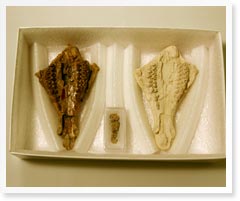Storing Your Fossils
Because they have survived for millions of years, fossils may seem to be almost indestructible. In fact, they are just as vulnerable to damage as any other museum specimen and as examples of our local, national, or world heritage it is important that they be stored properly to ensure that they can be preserved for future generations to learn from and enjoy.

One of the best ways to ensure preservation of fossils is by providing a safe and secure storage environment. This section explores some of the main points that should be considered when developing good collection management procedures for storing fossils. There are many different things that can be done. For a museum, it might involve the design of the buildings that are used to store fossils, or installing heating, ventilation, and air-conditioning (HVAC) plants to control the temperature and relative humidity of storage rooms. However, it also involves much smaller-scale, but equally important approaches that can be implemented by anyone, such as choosing archival materials for specimen boxes, trays, and labels, and using cabinets and boxes to create protective micro-climates. Solving these problems draws heavily on the expertise of the preservation and conservation professions.
Safe storage is not just about controlling the physical environment. Collection security is essential; institutions have to balance the need to make their collections accessible with their responsibility to keep them secure, which means that important decisions have to be made about who should have access to specimens, and how. Collections facilities are as vulnerable as any building to periodic disasters, such as floods and fires, and can also come under attack from lower-level, but more insidious risks, like insect damage. Having good policies and procedures in place to secure collection areas and control access, and to respond rapidly and effectively when problems arise, can greatly reduce the risk posed by these factors.
Museums and universities invest a lot of time, effort, and money in ensuring that specimens are properly housed. Some of these solutions are beyond the reach of private collectors, but others are comparatively simple and can significantly improve the long-term security of the collection. To find out more, see the detailed information in the Storing section of the site.
- Storage Environments
- Storage Furniture
- Mounts and Materials
- Integrated Pest Management (IPM)
- Risk management and disaster planning
To find out more about how fossil collections, once properly stored, can be used and shared with the wider public, see the next section on Tracking specimens.



